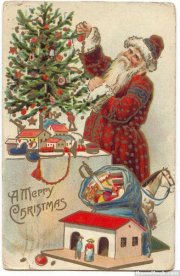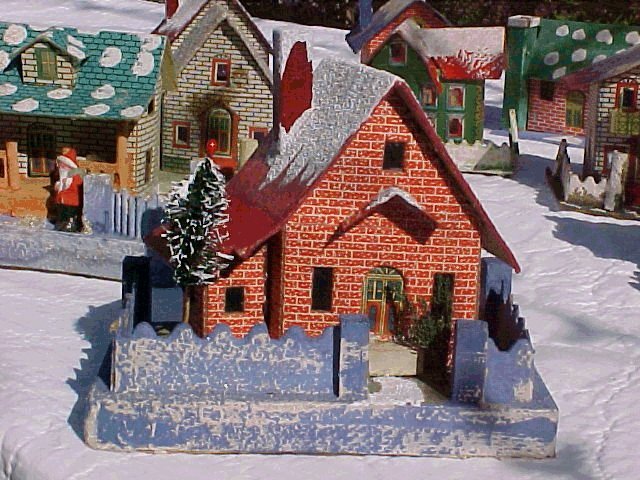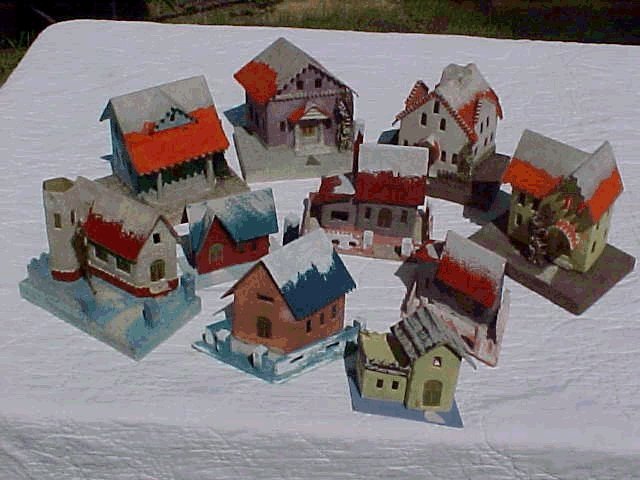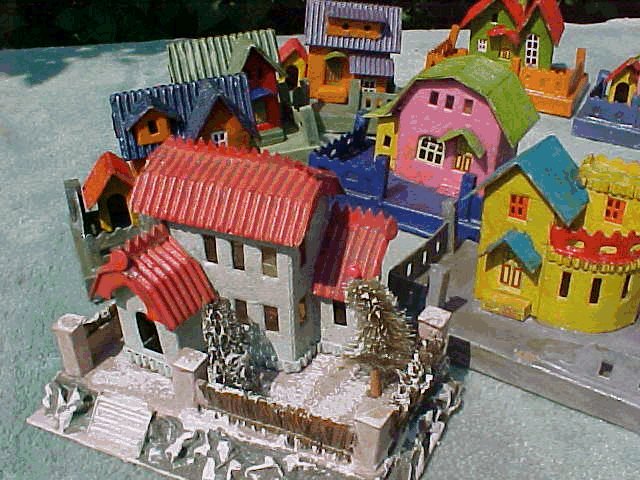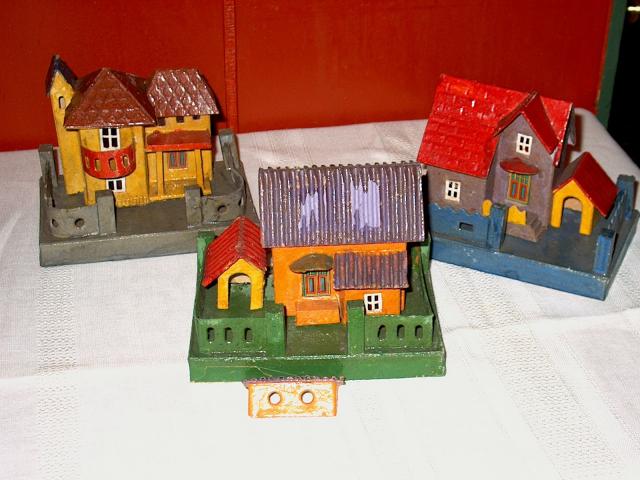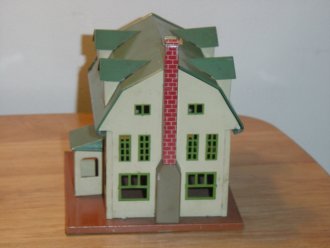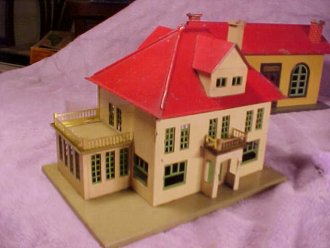|
For more information, please scroll to the bottom of the page. |
THE EARLY PERIOD
(The latter 1920's)
| A Christmas Visit to the 1920's |
| TABLE of CONTENTS |
| CATEGORIES |
| 1930's |
| WW II |
| POSTWAR |
| MAIN PAGE |

I was amazed to discover that the cardboard village houses do NOT go back to Victorian times as I had oft been told. I have yet to discover any catalogued reference to what we usually think of as these little houses prior to 1928. At this point of research that seems to be it: 1928.
I am doing my level best to push the date of the illuminated cardboard "Made-in-Japan" Christmas houses prior to 1928, but so far no luck. 1928 stands for now. I can't beat it. Believe me, I've tried! - and I am working on it daily!
Here is a catalog from 1926. It calls itself "The Baltimore Price Reducer," and, like the Butler Brothers of New York, seem ready to sell anybody anything in dozen lots at any time. This is a page from their Christmas stuff; ornaments and etc, and in this case HOUSES of a sort;


These are not the illuminated Christmas Village houses of investigation,here - but they are their direct ancestors. Little fancy boxes shaped like houses that came off their bases to reveal candies and small presents had been around since the turn of the 20th Century. Then ,inexpensive tree lights and electric trains came to the masses and these bloomed into a whole new category. The "candy/surprize" boxes were a form of small gift-wrapping delight enhancement, then, which evolved into the electrically illuminated villages so many of us came to know and adore.
The Charles Williams Catalog of 1927: - a firm with centers also in Pennsylvania and Arizona! These "wholesale-to-the-public" mail-order catalogs were a ubiquitous fact of life in those days.



I had found 6 different of the 12 of these tiny guys over the years, but never the whole set, or where they came from. I guess that latter is still up for grabs because there is no brand name to be found. The largest base dimension is 2 1/2". Many think they are German by the style, but the McLaughlin Bros. had a very European style and were 100% American. Your guess is as good as mine ...
UPDATE! Oct, 03,'09:
The full set has been found! Get the full story -
| October 2009 House of the Month |
The Real Thing Begins -
ca. 1928?

Montgomery Ward: Fall-Winter 1928-29

From Sears &Roebuck Fall-Winter 1929-30
I spent a day some time ago examining microfiched portions of Sears catalogs from 1909 to 1929 at the big Carnegie Library in Pittsburgh : the Toy and Holiday Trimmings sections.(Sears and Wards didn't begin having a separate Christmas "Wish Book" until 1932.) Around about 1927, they evolved quickly out of the imported "candy box" surprise containers -which do go back that far - during the 1920s. I believe they arose as a conjunction and accessory to the common series string of C-6 tree lights which became affordable and into widespread popular use during this exact same time period. Indeed, the fact they were so often sold in sets of 8 exactly coincides with the 8-lights-on-a-string series sets which remained the norm and mainstay of Christmas lighting until the early '60s when the subminiature "fairy lights" of today appeared and quickly took favor. Though they were probably sold in dime and department stores by the mid '20s - village houses do not appear in the Sears and Roebuck catalog until 1929! Montgomery Ward - 1928!. In the pages shown, these are small, flat-card based 3 1/2" X 1 3/4" sets of 8 - not very fancy or elaborate - probably playing "catch-up" to something already growing popular. The Ward's seem somewhat fancier, showing more complex detail, but it's hard to tell from these engravings. Actual photography does not come to these catalogs until 1934. Half the fun was trying to guess what a thing would actually look like when you got it!
But Japanese or American, sets of 8 were the rule after 1928. The little houses became the sisters of the lights.
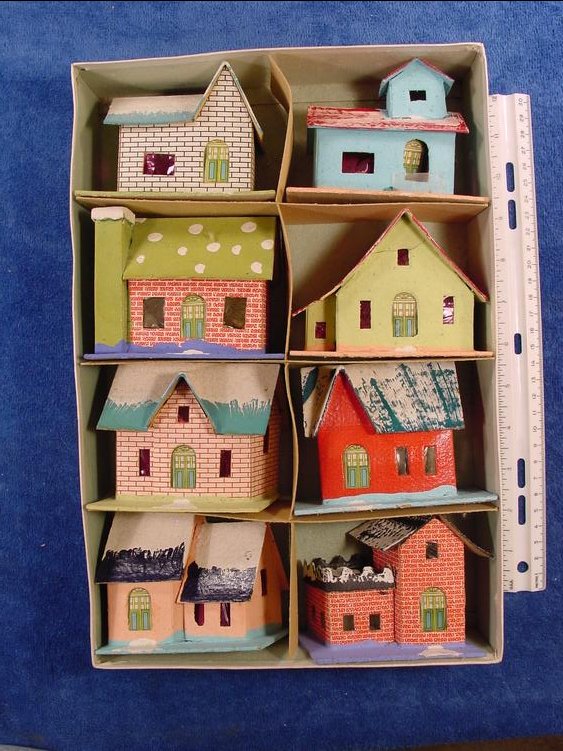 A pristine boxed set I believe to be the exact one represented in the
Sears/Roebuck ad above.
A pristine boxed set I believe to be the exact one represented in the
Sears/Roebuck ad above.
Both seem simply painted in the engraving, but the actual set reveals "Printie" sides on some and "Gloss-Top"(shellacked) roofs -especially the style of the roof snow - compare to the photos under Gloss-Tops below. The smaller houses shown are obviously orphans from one of these sets.
As mentioned above, the fact that village houses don't appear in the big mail order catalogs before these dates does not mean that they were not being sold in the 5&10's and department stores. I would bet that if anyone had them first it would have been F.W. Woolworth who introduced and thereafter literally built the German blown-glass ornament industry to supply his stores. I just don't know exactly the year that people start finding them in stores. Mid twenties at the earliest is my guess....

...and James S.Morrison's fabulous compendium of authentic old home Christmas photos A VINTAGE VIEW OF CHRISTMAS PAST would also seem to bear this out. One sees the cardboard houses in photos from the thirties on, but not before. Earlier putzes are seen to be comprised mainly of home made or tinplate train accessory buildings, albeit many amazingly elaborate and well-crafted things - but no dimestore cardboards. (This hard-to-find publication is a book the serious putz collector absolutely ought to have! If interested, click on this:
| Books and Movies |
.... What a "Time-Machine!" - I HIGHLY recommend!!!
- So, - I have yet to find solid documentary evidence of the Japanese cardboard village houses prior to 1928! I am constantly in search of ads from mailorder catalogs, wholesalers catalogs, dated old home photos, and the like. If anyone has such evidence, please come forth!You needn't part with your treasured collectibles - just e-mail me a .jpg photo. I'm dying to see it and revise the above remarks accordingly!
In the meantime, I find five basic types - with hybrid variations - starting in this earliest period: lacking any other references, I call them the: -
"PRINTIES,"- "GlOSS-TOPS," "CANDY-BOXES," "LAQUERS - ( shellacked "Lakkies") and the "LOG CABINS" - ("Loggies")
***
"PRINTIES"
The First Period: 1928-1930


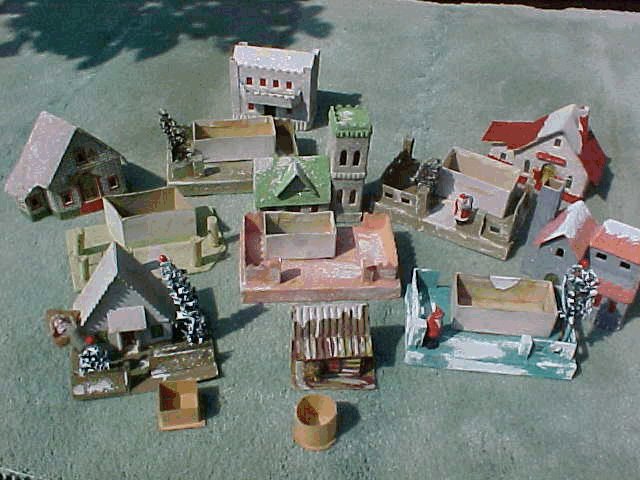

| CATEGORIES |
| 1930's |
| WW II |
| POSTWAR |
| MAIN PAGE |
| <REPRODUCTION PARTS |

For information about this site, please contact us at:
http://cardboardchristmas.com/papateds/contact.htm
|
Copyright 2000-2012 Theodore H. Althof,Jr.Except where noted, the contents of this website and all it's pages and submissions therein contained are the intellectual property of Theodore H.Althof,Jr. All rights are reserved. (Background musical selections are,of course, excepted.)
|
